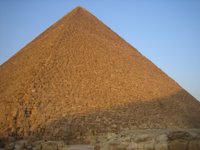Finally, El Harumatt!!

"Whats your opinion of Egypt?? How about those pyramids!!" Egyptians are always curious as to my thoughts of Egypt--its cities, its foods, its people, its monuments. And for the first three I've of course responded of my love for 'everything Egypt,' but of the last I have had to shamefully disclose that I had yet to visit its magnificent and world-renown monuments, the Harumatt. Yes, we really hit the ground running here. That, and the desert during a summer day isn't exactly pleasant. So I waited nearly three months and though it was still blazing saddles on November 26, my visit to the pyramids ect. today was truly an incredible experience. It is certainly true that there are some things that can never be captured in books and photos...
We started in Memphis, the original capital of Egypt and in fact one of the earliest settlements of humanity. Today it lies about 40 minutes south of Cairo by bus, and is nothing more than an agrarian community. Our bus took us on dirt roads past donkeys carrying loads of sugar cane, horse-drawn carts filled with tomatoes, and women gracefully (and amazingly) carrying today's water on their heads. Since the capital moved north closer to Cairo when the Roman's came around the turn of the millenium, Memphis gradually disappeared until all that remained were buried monuments of a time long past. When in the middle and late 1800's the Europeans began their Egyptology expeditions, they unearthed in Memphis a plethora of large sculptures, tablets, and sarcofaguses of ancient Egypt. The most notable were hauled away (and put in trophy cases in the British Museum and the Louvre), but many were left behind where they can be found in a small fenced in area about the size of a football field at the end of a dusty road 30 miles south of Cairo. We truly had a wonderful tour guide today who enlightened us naive westerners as to ancient Egypt.
As very similar to the concept of the emperor in China, the pharaoh in Egypt was the absolute link between God ('Rah' in hieroglyphics) and the people as his subjects. The famous pharaonic name of 'Ramses' actually comes from a combination of 'Rah' and 'masis,' which in hieroglyphics meant 'beloved son.' Therefore, the pharaoh was revered not simply as the iron-fisted ruler of the people, but as one who was the intermediary between heaven and earth. And so many monuments discovered and unearthed in the last one hundred years bear the images of rulers, along with the numerous dieties of ancient Egypt. Ongoing excavations will surely reveal many more artifacts like the ones on display in the Memphis.
From Memphis we made our way to the pyramid park. It is true that on a rare day of little pollution, one can see the pyramids from many spots in Cairo. I had seen them a couple of times from bus and taxi windows, and remember feeling as if I had greatly underestimated the magnitude of these famous structures. They are really huge. And they are even bigger when you stand at the bottom of them. Its like looking up at a magnificent and perfectly symmetrical mountain. How could humans have built this 137m tall mass of square blocks--precise to even the millimeter--and 5000 years ago?? Originally, a limestone casting coated the bulk of blocks that provided the structure of the pyramids making a smooth, tidy, and sheen covering to the pyramids. The top of the pyramid of Khafre still contains a little of this to convey the original completed project. As funerary complexes visible from great distances away, the pyramids allowed the pharaohs to be worshiped long after their death, reminding his subjects both of the eternal power of the gods and the absolute power of the pharoah. And I can truly say that even amongst the scores of tourists and hawkers peddling their wares and camel men begging you to take a ride, you really feel small at the foot of something so enormous and
 beautiful, even 5000 years later. Both the pyramids themselves and the work of those so long ago that struggled for 20 years to build these pyramids (fyi-new research is showing that it was probably not slaves that built the pyramids, but a highly organized class of Egyptian farmers working in the 4-month flood season for which they were idle) demands respect, necessarily drawing one into that ancient world of spirituality, honour, and remarkable achievement in the name of something much greater than human-kind.
beautiful, even 5000 years later. Both the pyramids themselves and the work of those so long ago that struggled for 20 years to build these pyramids (fyi-new research is showing that it was probably not slaves that built the pyramids, but a highly organized class of Egyptian farmers working in the 4-month flood season for which they were idle) demands respect, necessarily drawing one into that ancient world of spirituality, honour, and remarkable achievement in the name of something much greater than human-kind.
